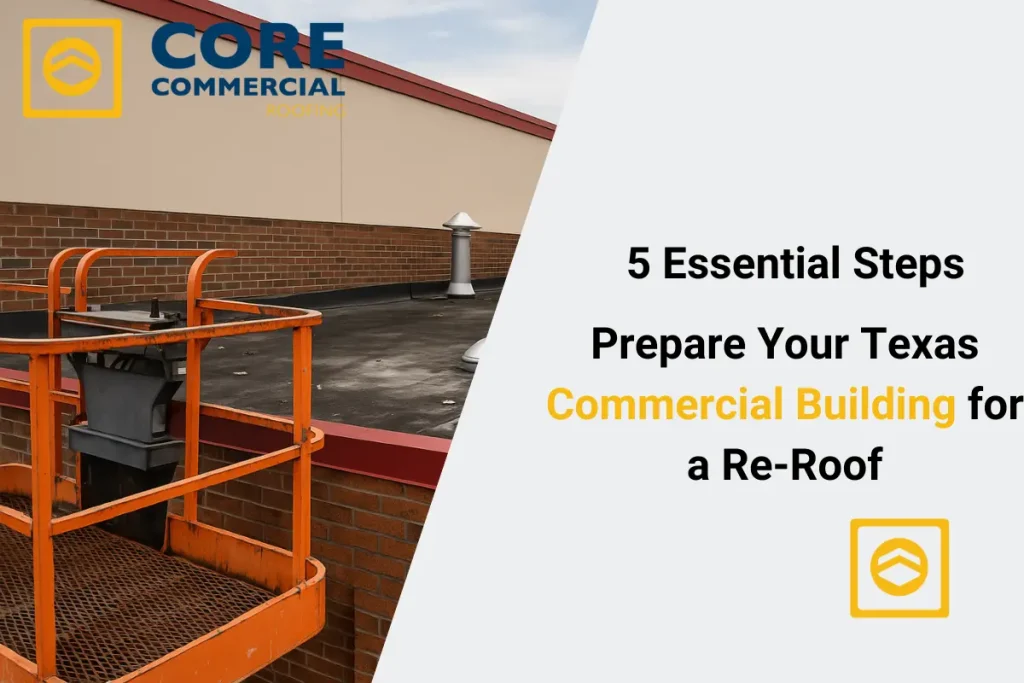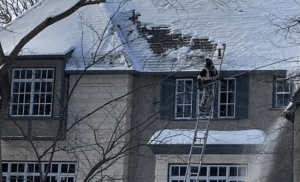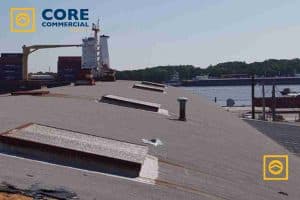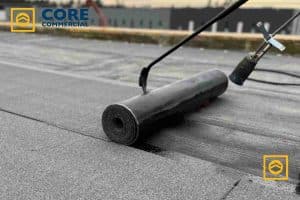Preparing your Texas commercial building for a re-roof is one of the most important investments you can make in protecting your property, employees, and business operations. A roof doesn’t just cover your building; it shields everything inside from harsh weather, water damage, and unexpected downtime.
Out of all the steps involved, one of our favorites, and most often overlooked, is scheduling a professional roof inspection before the work begins. This single action helps uncover hidden damage, creates a clear plan, and prevents costly surprises during the re-roofing process.
If you’ve been wondering how to get your building ready and avoid delays, this guide will walk you through the most important steps. By the end, you’ll know exactly what to do so your project runs smoothly, your building remains protected, and you gain confidence in the long-term value of your new roof.

Table of Contents
Step 1: Schedule a Detailed Roof Inspection
Before any re-roofing project begins, the first step is always a thorough inspection. This process identifies weak points, existing damage, and structural concerns that could affect the success of your new roof. In Texas, where high heat, storms, and seasonal shifts put pressure on roofing systems, inspections help property owners understand the true condition of their building.
A professional inspection provides several key benefits:
- Uncovers leaks or moisture buildup hidden under the surface.
- Evaluates drainage systems and gutters to prevent pooling water.
- Document damage for insurance purposes, which can offset project costs.
- Helps contractors plan more effectively and avoid unexpected delays.
Many property owners ask about the roof inspection cost in Lubbock, TX, and other cities. While prices vary, the cost is minor compared to the financial hit of discovering major problems mid-project.
Investing in a roof inspection ensures your re-roof starts on a strong foundation, saving time and money later.
Step 2: Prepare the Building Interior and Exterior
Re-roofing isn’t just about the roof itself; it impacts the entire building. Preparing both the inside and outside of your property helps prevent damage and keeps daily operations running smoothly.
Inside the building, cover equipment, machinery, and sensitive documents to protect them from dust or debris. If your business relies on electronics, disconnect and store critical equipment temporarily. In office spaces, communicate with employees so they know which areas will be affected.
Outside the building, clear parking lots, walkways, and storage areas near the roofline. Heavy equipment, dumpsters, and material staging areas will take up space, and creating a safe, clear environment prevents accidents.
For businesses serving customers, safety planning during roofing projects can help with signage, temporary barriers, and maintaining accessibility while ensuring safety.
By organizing both the interior and exterior, you’ll reduce disruptions, lower liability risks, and create an efficient working environment for the roofing crew.
Step 3: Choose the Right Roofing Material
One of the biggest decisions when preparing for a re-roof is selecting the right material. Each option offers different benefits depending on your climate, budget, and long-term goals.
- Metal Roofing – Known for its durability and long lifespan. Metal roofs reflect heat, lower energy bills, and resist wind, hail, and fire. Professional metal roof installation is critical to maximize its benefits.
- TPO & PVC Membranes – Excellent for flat or low-slope commercial roofs, providing waterproofing and energy efficiency.
- Modified Bitumen & BUR – Ideal for heavy-duty applications, offering layered protection and long service life.
The right material should balance upfront costs with long-term savings, energy efficiency, and the unique challenges of Texas weather. Talking to your commercial roofing contractor will help you make a confident decision.
Step 4: Plan for Safety and Business Continuity
Safety and business continuity go hand in hand during re-roofing. A well-prepared plan ensures employees, customers, and tenants stay safe while also reducing downtime.
First, coordinate with your roofing team on protective barriers, rerouting foot traffic, or scheduling noisy work during off-hours.
Second, think about operations. Warehouses may need to shift schedules, office buildings might offer remote work options, and retail businesses can use clear communication strategies to reassure customers they remain open.
By planning carefully, you’ll protect both people and productivity, making the re-roofing process less stressful for everyone.
Step 5: Schedule Ongoing Maintenance After the Re-Roof
Many property owners think the work ends with installation, but ongoing upkeep ensures the long life of your investment. Preparing your Texas commercial building includes planning for future care.
Commercial roof maintenance should be part of your strategy. This includes:
- Regular inspections
- Seasonal checkups after storms
- Timely repairs before small issues grow
Preventive maintenance not only extends the lifespan of your roof, it also keeps warranties valid and lowers long-term costs.
Think of maintenance as insurance for your investment. A new roof can last decades, but only if it receives consistent attention. Partnering with professionals who provide scheduled checkups will help you stay ahead of problems and preserve your property’s value.
The Benefits of Proper Preparation
When you prepare your Texas commercial building the right way, you gain more than just a smooth project. You gain confidence that your investment will last, your operations will continue without major interruptions, and your building will be safer and more energy-efficient for years to come.
Some of the biggest benefits include:
- Reduced surprises through inspections and planning
- Lower costs from avoiding damage and delays
- Better safety for employees, tenants, and customers
- A longer roof lifespan with ongoing maintenance
- Peace of mind knowing your building is protected
Proper preparation turns a re-roof into a long-term improvement for your property.
Conclusion
Preparing your Texas commercial building for a successful re-roof requires careful planning, attention to detail, and a focus on long-term results. By scheduling roof inspections, preparing your property, choosing the right materials, prioritizing safety, and committing to roof maintenance, you set your building up for decades of protection.
Every step you take, both before and after installation, directly impacts the outcome. The more effort you put into preparation, the fewer problems you’ll encounter down the road. Whether you’re considering a metal roofing upgrade, researching commercial roofing systems, or exploring maintenance programs, the key is being proactive.
Take action now, and your building will remain strong, efficient, and well-protected against Texas weather for years to come.
FAQs
What are the steps to prepare a commercial roof in Texas?
Preparing a commercial roof in Texas involves assessing the current roof condition, coordinating with occupants, protecting interior assets, securing the exterior, and reviewing permits and contractor agreements. These steps help ensure a smooth re-roofing process and minimize disruptions.
Do I need a permit for commercial roof replacement in Texas?
Yes, most Texas municipalities require permits for commercial roof replacements. Obtaining the necessary permits ensures compliance with local building codes and safety standards. Check with your local permitting office for specific requirements.
How can I protect my building’s interior during re-roofing?
Protecting the interior involves covering equipment and sensitive areas with tarps or plastic sheeting, relocating valuable items, and sealing off work zones. This helps prevent damage from debris and dust during the roofing process.
How to coordinate with tenants during a roof replacement?
Inform tenants well in advance about the roofing schedule, potential disruptions, and safety measures. Provide clear communication channels for updates and address any concerns promptly to maintain good relationships and minimize inconvenience.
What should a commercial roof inspection checklist include?
A comprehensive inspection checklist should cover surface damage, drainage systems, flashing, vents, seals, rooftop equipment, and interior ceiling checks. Regular inspections help identify issues early and extend the roof’s lifespan.
How do I secure the exterior before a commercial re-roof?
Secure the exterior by clearing parking and loading zones, trimming nearby trees, ensuring site access, and informing security teams. This preparation facilitates efficient work and enhances safety during the roofing project.
What are the common signs that my commercial roof needs replacing?
Common signs include water stains on ceilings or walls, sagging roof sections, visible cracks or blisters on the roof surface, and clogged gutters. These issues indicate potential leaks or structural problems that may require roof replacement.
How can I minimize business disruption during re-roofing?
To minimize disruption, schedule work during off-peak hours, coordinate with tenants, establish clear communication, and ensure safety measures are in place. Proper planning helps maintain business operations during the roofing process.
Are there specific Texas codes for commercial roofing?
Yes, Texas has specific building codes and regulations for commercial roofing projects. These codes ensure safety, durability, and compliance with industry standards. Consult local authorities or a professional contractor for detailed information.
What is the best time of year to re-roof in Texas?
The ideal times for re-roofing in Texas are during the spring and fall, when weather conditions are typically mild. Avoiding extreme heat or storm seasons helps ensure a smoother and safer roofing process.





